“Levateur” vs. “Levitation” Comparing the Outdoor Sculptures of Tony DeLap
May 1, 2017
Nestled between the Leatherby Libraries and Oliphant Hall stand two unusual steel sculptures. Both demand attention from all who walk this space; one is perched atop two uneven grassy knolls, creating an overhead canopy, while the other stands among the passersby, leaning precariously into their space. These pieces, titled The Levitation of the Enchanted Princess and Le Levateur, are by Tony DeLap, a key figure in the op art and “Light and Space” movements of the 1960s and 1970s. These movements were experimental in their use of geometric shapes, and are concerned with the viewer’s perception of reality. Both of DeLap’s outdoor sculptures embody these ideologies, and are constructed from steel that has been manipulated into shapes with straight lines and steep angles.
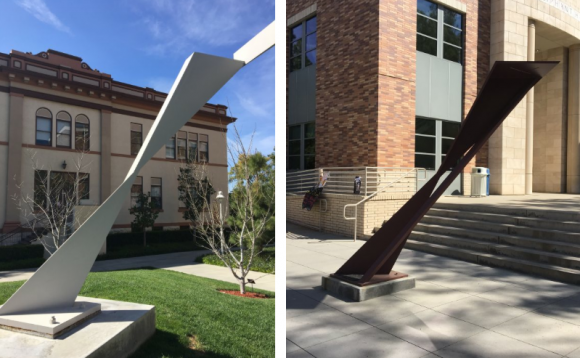
The steep angles and sharp geometry of the light colored bases of The Levitation of the Enchanted Princess (pictured right) create an interesting conversation between the darker, singular structure Le Levateur (left).
DeLap was born in Oakland, California in 1927, and studied in the Bay Area. When he was a young boy, he watched the construction of the Golden Gate Bridge in San Francisco, an experience that is widely believed to have influenced his approach to art making. This influence can be easily read in the bridge-like Levitation of the Enchanted Princess, which was built specifically for Chapman and the plot of land upon which it currently sits in 1983.
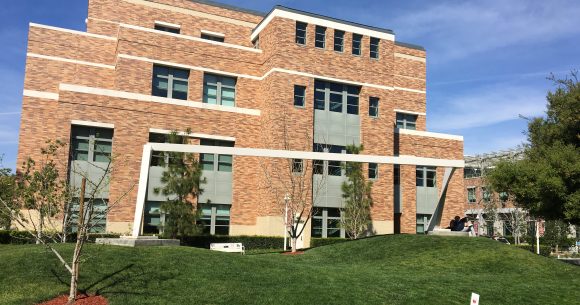
The Levitation of the Enchanted Princess, Tony DeLap, 1983. Steel. Escalette Permanent Collection of Art.
The sculpture’s bases are placed upon two hills that create a sloping valley between them. The grassy area, while being surrounded on all sides by buildings with this geometric sculpture looming overhead, is somewhat fenced in by trees of various sizes, thereby creating a space that unifies nature and architecture, the natural and the man-made. It is a quiet space where many students can be found picnicking, studying, or simply enjoying a sunny day.
The dual supports on either side of the center beam make the piece feel like it is rising out of the ground, and from certain angles, appears to be a completely level surface. It is only by walking beneath and around the piece, viewing it from all sides, does the viewer realize just how asymmetrical, angled, and contorted the structure is.
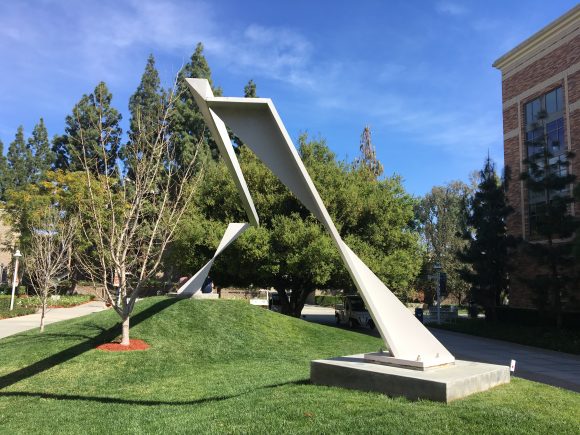
Alternate view of The Levitation of the Enchanted Princess, Tony DeLap, 1983. Steel. Escalette Permanent Collection of Art
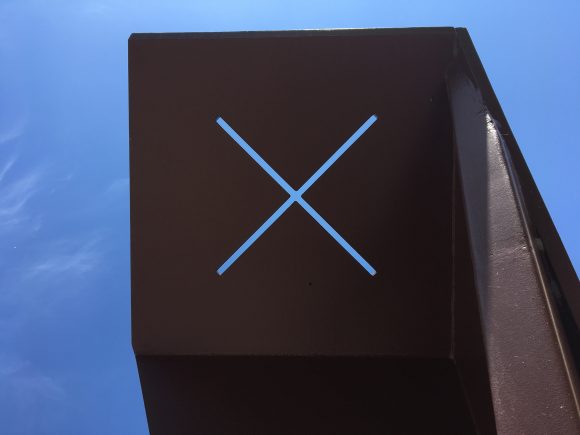
Detail of Le Levateur, Tony DeLap, 1987. Steel. Escalette Permanent Collection of Art.
While both The Levitation of the Enchanted Princess and Le Levateur create space for its viewers to interact, Le Levateur is far more active in its utilization of negative space. The steel of this piece is angled so dramatically that it becomes physically invasive, and its placement at the foot of the stairs leading up to Oliphant Hall demands the attention of its audience. As the sun crests the Hall, the resulting shadow becomes an extension of Le Levateur, rendering it a different piece with every passing moment. This is further emphasized by the top of the sculpture, a flattened square piece with an X-shaped incision in the center. Visit the sculpture in the early afternoon to see the sun cast a perfect “X” on the ground.
Le Levateur was originally painted blue and was installed in the middle of a planter, as seen in the picture below. Upon being moved to Chapman University’s main campus, it was changed to its current, brown-red color and was placed at ground level. This new location proves far more effective in appreciating all of the sculpture’s varying attributes. The shadow is now cast upon a flat surface that is immediately within the viewer’s space, as opposed to being elevated and cast over the uneven surface that was the planter. The piece’s color change, as well, coordinates better with the earth tones found in the brick of Oliphant Hall. One could argue that Le Levateur is almost a completely different piece when considering its location and appearance before its move to Chapman University. Whereas its former elevated base and blue color connected it more to the sky, the new ground-level base and rich, red color connects it more to the Earth.
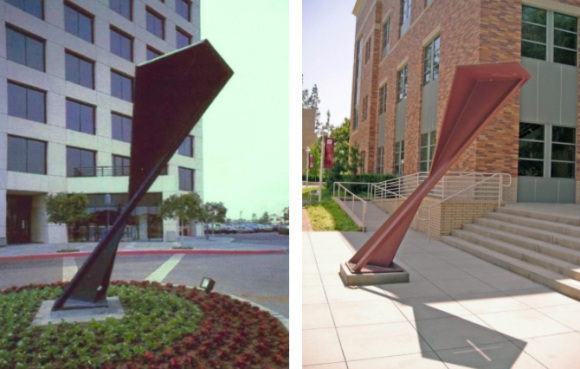
Left: The original location and color of Le Levateur. Right: Le Levateur as it looks now at its current location at Chapman University.
The names of these DeLap sculptures also are connected by their titles; The Levitation of the Enchanted Princess and Le Levateur. “Levateur” is akin to the French word, “élévateur,” or elevator, but does not have a literal translation itself. Nevertheless, the title evokes the idea of lifting, rising, and floating. The Levitation of the Enchanted Princess‘s title makes this evocation directly, and creates a strong sense of the piece’s “weightless” qualities, connecting the long steel beam between the two slanted base pieces. Both “levitations” appear to defy the laws of gravity, and thereby create a constantly changing dialogue between not only the pieces and their viewers, but between these similar sculptures themselves.
To see these two unique pieces of art along with the rest of the Escalette outdoor sculpture collection, schedule a tour with the Art Collections by contacting artcollections@chapman.edu.
All text and images under copyright. Please contact artcollections@chapman.edu for permission to use. Information subject to change upon further research.


